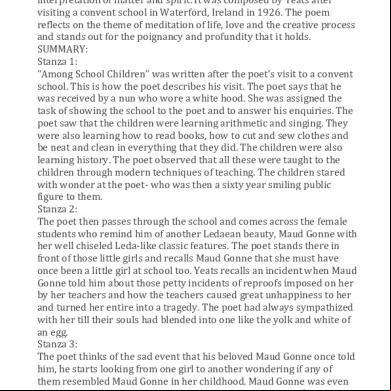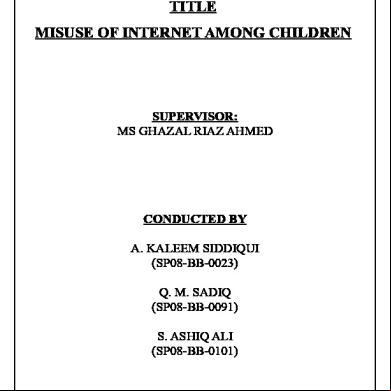Among School Children Themes 42141
This document was ed by and they confirmed that they have the permission to share it. If you are author or own the copyright of this book, please report to us by using this report form. Report 2z6p3t
Overview 5o1f4z
& View Among School Children Themes as PDF for free.
More details 6z3438
- Words: 789
- Pages: 2
“Among School Children” by William Butler Yeats is among the most famous English poems of the 20th century. It is an eight stanza poem which reflects many themes. There are several themes that are common throughout the poems of William Butler Yeats. Many of poems by W.B. Yeats reflect an unrelenting obsession with the past, and his fear of growing old or aging and a persistent fear of death, unrequited life-long love for Maud Gonne, and numerous references to youth, education and journey of life. The theme of youth and old age is very prominent in “Among School Children”. Yeats frequently compares and contrasts between these two. In the very first stanza being clearly conscious of his old age he addresses himself as a “sixty-year-old smiling public man”. Then in third stanza he visualizes Moude Gonne in a child before him whose Gonne’s youthful purity hypnotizes him. But immediately, he compares her childhood with her present age. In her growing age, she is now “hollow of cheek. He also reminisces a moment of his own previous “pretty plumage” when he had jet-black hair as a young man. But then snaps back to the present. Through these quick shifts he reveals how much he is conscious of his growing age. In stanza four; he portrayed the disappointed of mothers seeing their child becoming aged. Lastly, he says though every human know aging is part of life, still we all are self mocker of our old age. Besides this, there are also several major and minor themes in this poem. Among them most common one is his unrequited love for Moude Gonne. Most of his poems somehow have the presentation of Moude Gonne. Sometimes he recalls her or sometimes glorifies her. Similarly, in this poem he firstly he imagines her in children. Then reminisce a moment of their youth. He compares her beauty with that of Helen. He also describes Gonne’s swan-like beauty, saying, “Even the daughters of the swan can share something of every paddler’s heritage.” Slipping deeper into his imagination, Yeats ionately portrays Gonne, until “she stands before me as a living child.” Tragically, Yeats knows that this perfection will eventually be corrupted, causing Yeats to have a “fit of grief or rage” At the beginning of the poem we also get the theme of contrast between knowledge and experience. He Talks about the way of modern learning, though he didn’t explain elaborately. He only wants to know whether the lessons they are being taught is really relevant to life. They learn “to cipher and to sing, to study
reading-books and history," but Yeats realizes that life’s true lessons do not come from the classroom rather from experience or age. He also brings theme of transformation from innocence to maturity with references of legend of Leda whose innocence was violated by Zeus. Yeats relates the rape of Leda by Zeus with these innocent children’s turning of a “childish day to tragedy.” Leda’s body “bent/ above a sinking fire” is symbolic of her diminishing youthful spirit; Leda loses the purity of her youth through one “trivial event." Yeats knows that later in life, these children, with the same Leda-like innocence, will have to be stripped of their purity. This change parallels Leda’s, and the children’s, transition from innocence to knowledge. Then, he brings Plato’s “Symposium”, which propounded the idea or theme that the gods created men and women by splitting a near-spherical shape into two halves. The ion is a mere series of attempts to regain this lost unity. He imagines, he and Maud Gonne, like Plato’s parable, being together as the “yolk and white of the one shell." Then he brings the theme of body and soul as inseparable part of life. He said body and soul can’t be existed solely. Yeats recognizes that although people are the sum of their separate deeds, life is an amalgamation of actions. Instead of viewing life in parts, like “the leaf, the blossom, or the bole,” Yeats argues for one, united view of life. Like one’s inability to separate the “dancer from the dance”, one cannot separate life from death. These two parts are not independent. Instead, they are one in the same. No one has life, without death. So, one should not view them independently, choosing to takes all areas of life in one wide swath. Conclusion and Criticism: ‘Among School Children’ finds its solution to the dichotomy between the children and the ageing man. Yeats realizes the fleeting nature of life, accepting human frailty and the inevitability of aging. After wearing the false mask of acceptance for so long, he finally realizes that no matter who the man, and irrespective of his deeds, death is an inevitable part of life.
reading-books and history," but Yeats realizes that life’s true lessons do not come from the classroom rather from experience or age. He also brings theme of transformation from innocence to maturity with references of legend of Leda whose innocence was violated by Zeus. Yeats relates the rape of Leda by Zeus with these innocent children’s turning of a “childish day to tragedy.” Leda’s body “bent/ above a sinking fire” is symbolic of her diminishing youthful spirit; Leda loses the purity of her youth through one “trivial event." Yeats knows that later in life, these children, with the same Leda-like innocence, will have to be stripped of their purity. This change parallels Leda’s, and the children’s, transition from innocence to knowledge. Then, he brings Plato’s “Symposium”, which propounded the idea or theme that the gods created men and women by splitting a near-spherical shape into two halves. The ion is a mere series of attempts to regain this lost unity. He imagines, he and Maud Gonne, like Plato’s parable, being together as the “yolk and white of the one shell." Then he brings the theme of body and soul as inseparable part of life. He said body and soul can’t be existed solely. Yeats recognizes that although people are the sum of their separate deeds, life is an amalgamation of actions. Instead of viewing life in parts, like “the leaf, the blossom, or the bole,” Yeats argues for one, united view of life. Like one’s inability to separate the “dancer from the dance”, one cannot separate life from death. These two parts are not independent. Instead, they are one in the same. No one has life, without death. So, one should not view them independently, choosing to takes all areas of life in one wide swath. Conclusion and Criticism: ‘Among School Children’ finds its solution to the dichotomy between the children and the ageing man. Yeats realizes the fleeting nature of life, accepting human frailty and the inevitability of aging. After wearing the false mask of acceptance for so long, he finally realizes that no matter who the man, and irrespective of his deeds, death is an inevitable part of life.










